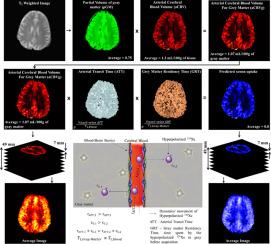Measurement and modeling of xenon gas transfer in the human brain with 1H and hyperpolarized 129Xe MRI
IF 2.624
引用次数: 0
Abstract
Background
The feasibility of imaging hyperpolarized 129Xe dissolved in brain tissue following inhalation of xenon gas in the lungs has recently been demonstrated in humans. The image contrast in 129Xe brain MRI represents a combination of factors, including regional perfusion, polarization decay and gas transfer rate across the blood-brain barrier.
Purpose
To investigate the repeatability of hyperpolarized 129Xe brain MRI in healthy normal individuals and to identify the dominant mechanisms of image contrast by assessing voxel-wise correlation between HP 129Xe brain MRI and models of 129Xe brain uptake derived from 1H arterial spin labeling (ASL) perfusion mapping.
Materials and Methods
To assess repeatability, 3 sets of hyperpolarized 129Xe brain images were acquired from 5 healthy volunteers. Quantitative maps of the human brain, including cerebral blood flow, volume and predicted xenon uptake, were derived from 1H arterial spin labeling and T2-weighted MRI. These maps were then spatially cross-correlated with hyperpolarized 129Xe brain MRI.
Results
Signal to noise ratios of 8.7–17.7 were observed across volunteers for a voxel size of 8 × 8 × 50 mm3 with intra-subject repeatability of between 6 and 29 %. Hyperpolarized 129Xe brain images showed voxel-wise correlations with cerebral blood flow (R = 0.32 to 0.62), volume (R = 0.33 to 0.63) and predicted xenon uptake (R = 0.34 to 0.63), but did not correlate with arterial transit time (R = 0.05 to 0.26).
Conclusion
Voxel-wise cross correlation between 129Xe and 1H ASL suggests that the regional quantity of dissolved xenon delivered by cerebral blood flow is the dominant mechanism of image contrast in HP 129Xe brain MRI, assuming normal blood-brain barrier function. Combining 1H and 129Xe brain MRI provides new opportunities to quantitatively investigate brain pathophysiology and function.

利用 1H 和超极化 129Xe MRI 测量人脑中的氙气转移并建立模型
背景最近在人体中证实了对肺部吸入氙气后溶解在脑组织中的超极化 129Xe 进行成像的可行性。129Xe 脑磁共振成像的图像对比度由多种因素共同决定,包括区域灌注、偏振衰减和气体通过血脑屏障的传输速率。目的通过评估 HP 129Xe 脑磁共振成像与 1H 动脉自旋标记(ASL)灌注图得出的 129Xe 脑摄取模型之间的体素相关性,研究健康正常人的超极化 129Xe 脑磁共振成像的可重复性,并确定图像对比度的主要机制。通过 1H 动脉自旋标记和 T2 加权磁共振成像得出人脑的定量图,包括脑血流量、体积和预测的氙摄取量。结果在体素大小为 8 × 8 × 50 mm3 的情况下,不同志愿者的信噪比为 8.7-17.7,受试者内的重复性为 6%-29%。超极化 129Xe 脑图像与脑血流量(R = 0.32 至 0.62)、体积(R = 0.33 至 0.63)和预测氙摄取量(R = 0.34 至 0.63)呈体素相关性,但与动脉通过时间(R = 0.05 至 0.26)不相关。结论 129Xe 和 1H ASL 的象素交叉相关性表明,假设血脑屏障功能正常,脑血流输送的区域溶解氙数量是 HP 129Xe 脑磁共振成像图像对比的主要机制。结合 1H 和 129Xe 脑磁共振成像为定量研究大脑病理生理学和功能提供了新的机会。
本文章由计算机程序翻译,如有差异,请以英文原文为准。
求助全文
约1分钟内获得全文
求助全文

 求助内容:
求助内容: 应助结果提醒方式:
应助结果提醒方式:


